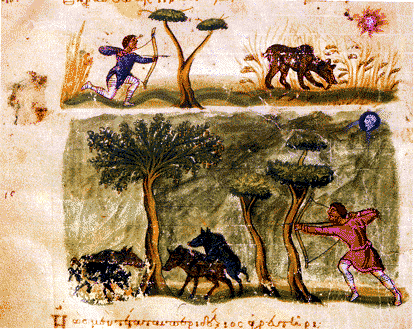|
HOME
ABOUT
TITLES
ORDER
E-MAIL
|
the illustrations of the cynegetica
in venice
codex
marcianus graecus Z 479
by
Ioannis Spatharakis
Oppian's Cynegetica is a hunting treatise offered to the Roman Emperor
Caracalla in 215 A.D. The manuscript in Venice is the only illustrated
copy of an antique author dealing with this subject. It comprises
167 miniatures, all of which are reproduced here in full colour.
They show horses and dogs, and animals that are hunted, their habits,
and the methods appropriate to their capture. They are enriched with mythological
scenes, some of which show unique subjects. The scenes include the hunting
of lions, tigers, leopards, jackals, lynxes, bears, wolves, foxes, hyenas,
wild boars, wild asses, wild horses, gazelles, porcupines etc. The manuscript
was painted in Constantinople in the middle of the eleventh century; the
ultimate model of the artist was most probably illustrated in antiquity.
The large number of miniatures, together with their high quality and the
rarity of the themes depicted, establishes this manuscript as one of the
most important illuminated manuscripts of the Middle Ages.
The
author is an expert in illuminated manuscripts and has several publications
of this subject in his name. He examined here the iconography of the scenes
in comparison with other relevant scenes, not only in Byzantium but also
in antiquity. Animals and hunting scenes, which predominate in the illustrations
of this manuscript, were also among the favourite subjects with which
the Romans embellished their palaces, villas and public buildings. They
are found on mosaic pavements all over the Empire, from England and Gaul
to North Africa and the Near East. The
author studied the miniatures of the manuscript in relation to the text
of the Cynegetica. Whenever a scene contained more details than provided
by the text, or did not correspond to it, he located an alternative text
that fits the miniature better. For this purpose several classical authors,
who deal with similar topics, were consulted and cited. He found satisfactory
texts and has reasonably argued that the texts of Xenophon's Cynegeticus,
Dionysius' Ixeutica, Oppian's Halieutica and the Alexander Romance of
Pseudo-Callisthenes could once have been illuminated, and that they may
have been used as a model by the illuminator of the Cynegetica.
CONTENTS: Foreword, Introduction,
Description
of the manuscript, The minaitures and their relation to the text (Books
one to Four), Iconographic and stylistic analysis of the miniatures, The
date of the manuscript, Prototype or copy? Literary and artistic sources
of the Cynegetica, The dates of the illuminated archetype and prototype,
The Cynegetica and relevant scenes in the Art of the Middle Byzantine
Era, Conclusions, Bibliography, Index, List of Illustrations. "This
edition of the Marcianus Cynegetica is indispensable not only for the
study of the manuscript, but also of the other illuminated 'secular'
manuscripts produced in Byzantium in the Middle Ages," Christopher
Walter, in Revue des Etudes Byzantines, 64/65 (2006/2007), 410-411.
Bound,
24 x 17 cm., 400 pp. (288 pp. text, plus 184 illustrations in full
colour and 58 in black and white)
2004
ISBN 90-806476-4-0
Price: Euro
250
| 
Oppian's Cynegetica MS Marcianus gr. 479, fol. 4vo,
Hunting by day and hunting by night |
|

